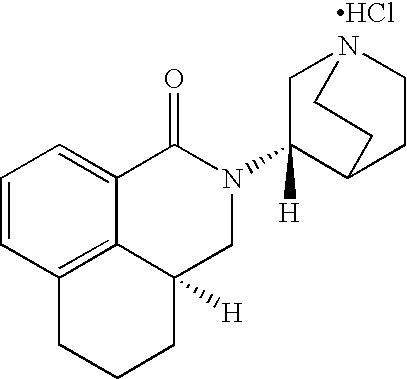Palonosetron for the treatment of chemotherapy induced emeses
a technology of chemotherapy and radiotherapy, applied in the field of palonosetron, can solve the problems of less effective control of delayed nausea and vomiting, affecting the quality of life of people undergoing such treatment, and the present class of 5-htsub>3/sub>antagonists has not been particularly helpful in meeting this need, so as to achieve heightened potency and reduce the incidence of unwanted side effects
- Summary
- Abstract
- Description
- Claims
- Application Information
AI Technical Summary
Benefits of technology
Problems solved by technology
Method used
Image
Examples
example 1
Antiemetic Effects of Palonosetron in Animal Models
[0086] The antiemetic effects of intravenously and orally administered palonosetron were assessed in male and female dogs (sexes combined). Antineoplastic agents employed in these experiments included cisplatin (3 mg / kg) ), dacarbazine (30 mg / kg), mechlorethamine (0.4 mg / kg) and actinomycin D (0.15 mg / kg).
[0087] Palonosetron and comparator drugs were administered prior to or after antineoplastic agents and animals were observed for the number of emetic episodes. Mean numbers of episodes were computed and the statistical significance of differences between treatment groups were determined with Dunnett's t test. Solutions of palonosetron and comparator drugs (ondansetron and granisetron) were prepared in distilled water. Vehicle control groups received distilled water.
[0088] The therapeutic effects of intravenously and orally administered palonosetron were compared to those of ondansetron and vehicle in cisplatin-treated dogs. When...
example 2
Duration of Action in Cisplatin-Treated Dogs
[0093] The durations of action of intravenously administered palonosetron, ondansetron and granisetron in dogs were compared in an experiment, the results of which are shown in Table 3. In this study groups of six dogs received intravenous doses of palonosetron, ondansetron, or granisetron (0.1, 0.15, or 0.04 mg / kg, respectively), or vehicle control 12, 10, 8, 6, 4, 2, or 1 hour prior to the intravenous injection of 3.0 mg / kg of cisplatin.
TABLE 3Duration of Action of Intravenously Administered Palonosetron,Ondansetron, or Granisetron in Cisplatin-Dosed DogsDosePre-Cisplatin (hr)Treatment(mg / kg)Emetic Episodes (mean ± SD)12Vehicle017.33 ± 4.68Palonosetron0.113.17 ± 6.27Ondansetron0.1522.00 ± 8.32Granisetron0.0415.67 ± 6.2810Vehicle019.33 ± 5.68Palonosetron0.1 9.83 ± 4.79bOndansetron0.1513.83 ± 4.58Granisetron0.0423.00 ± 5.878Vehicle020.00 ± 4.94Palonosetron0.1 9.50 ± 5.50bOndansetron0.1515.50 ± 7.29Granisetron0.0414.67 ± 8.696Vehicle01...
example 3
Relationship Between Systemic Exposure and Antiemetic Effect
[0095] An experiment was conducted to study the relationship between plasma concentration of palonosetron and protection of dogs against cisplatin-induced emesis. Groups of dogs received oral doses of palonosetron (0, 100, 316, or 1000 μg / kg) or vehicle control 30 minutes prior to the injection of cisplatin. Plasma concentrations of palonosetron were determined by an HPLC-radioimmunoassay method at 0, 0.25, 0.5, 1, 2, 4, 8, 24, and 48 hours after administration of palonosetron and systemic exposure was expressed as AUCO-4 hr. Results are summarized in Table 4.
TABLE 4Systemic Exposure of Palonosetron (AUC0-4 hr) in Dogs After IntravenousAdministration and Effects on Cisplatin-Induced EmesisEmetic EpisodesPalonosetron (μg / kg)NAUC0-4 hr (mean ± SD)(mean ± SD)0 (vehicle)6 0.00 ± 0.00a15.83 ± 3.43 100610.59 ± 7.24a1.83 ± 1.60b3166 30.64 ± 12.02a4.50 ± 6.83b10006 76.07 ± 50.39a5.67 ± 5.32b
aSignificantly different from all oth...
PUM
| Property | Measurement | Unit |
|---|---|---|
| time | aaaaa | aaaaa |
| concentration | aaaaa | aaaaa |
| body weight | aaaaa | aaaaa |
Abstract
Description
Claims
Application Information
 Login to View More
Login to View More - R&D
- Intellectual Property
- Life Sciences
- Materials
- Tech Scout
- Unparalleled Data Quality
- Higher Quality Content
- 60% Fewer Hallucinations
Browse by: Latest US Patents, China's latest patents, Technical Efficacy Thesaurus, Application Domain, Technology Topic, Popular Technical Reports.
© 2025 PatSnap. All rights reserved.Legal|Privacy policy|Modern Slavery Act Transparency Statement|Sitemap|About US| Contact US: help@patsnap.com

